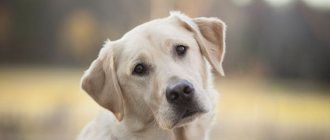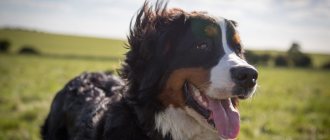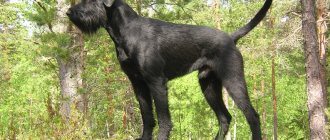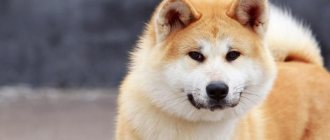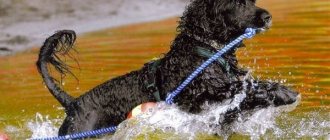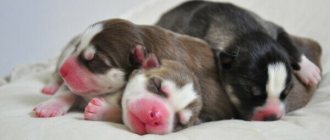If you are a happy, but still inexperienced “guardian” of the Bernese tailed family and are worried about when to start the first feeding of Mountain Dog puppies, we want to reassure you that you do not need to feed the puppies on your own until two and a half to three weeks, or even longer. Of course, if your shepherd is healthy and lactation is normal - which means that all puppies have noticeably gained in size, sleep well, do not worry and do not squeak. Next, without separating the babies from their mother’s milk, you should give them small complementary foods 3-4 times a day.
After a month, the frequency of “attachments” to the mother is reduced and by 1.5–2 months they try to completely transfer the puppies to an “alternative source of nutrition.” By the way, Blitz dry food is suitable for feeding even such babies, but in principle, you can start complementary feeding with canned food.
Rating of the 10 best dry food for the Bernese Mountain Dog
| Place | Name | Rating | Price, rub. |
| 1 | Belcando Junior Maxi for large and giant breed puppies from 3 to 18 months (15 kg) | 10 / 10 | 5 214 |
| 2 | Acana Puppy Large Breed, 11.4 kg | 10 / 10 | 5 050 |
| 3 | Royal Canin Maxi Adult, 15 kg | 9 / 10 | 4785 |
| 4 | Almo Nature Holistic beef 12 kg | 9 / 10 | 4279 |
| 5 | Purina Pro Plan Optiderma for healthy skin and coat, salmon with rice, 14 kg | 8 / 10 | 4113 |
| 6 | Brit Care lamb with rice 12 kg | 9 / 10 | 3999 |
| 7 | OUR DIET WITH BEEF, 15 kg | 7 / 10 | 1670 |
| 8 | Pedigree for healthy skin and coat, beef, 13 kg | 7 / 10 | 1399 |
| 9 | CHAPPI MEAT ABUNDANCE WITH VEGETABLES AND HERBS, adults, 15kg | 7 / 10 | 1381 |
| 10 | ALL DOGS (13 kg) Dry complete | 6 / 10 | 1153 |
Dry dog food is a complete nutritious diet for a pet, developed taking into account the physiology and characteristics of the animal. It contains carbohydrates, fats, proteins, and amino acids in a balanced state. When choosing, pay attention to the composition. The product must contain fats of animal and plant origin and natural ingredients. This is what dogs should receive to be healthy and cheerful.
Diseases and life expectancy
Bernese Mountain Dogs, like many large, loose, heavy dogs, suffer from hip dysplasia and, less commonly, elbow dysplasia. As it grows, it manifests itself as lameness and a peculiar gait. Among other pathologies of the musculoskeletal system, congenital brachial osteochondrosis occurs. Eye diseases - cataracts, entropion. Digestive tract – intussusception.
Life expectancy is 8-10 years. Dog handlers note with sadness that this figure has a downward trend. The reason is poor-quality breeding (so-called breeders who allow animals that do not meet breed standards to be mated) and the transfer of the dog to conditions that are uncomfortable for this breed.
Feeding
To be healthy, she needs to exercise a lot and stick to a proper diet.
The main element of a shepherd's diet is protein. The finished mixture should contain 40%-50% protein obtained from beef, chicken, offal, and in higher quality turkey and veal products. Take the Attention Test! Find 10 differences! (click right here!)
Find the answer Are you bothered by some problem or question? Enter “Breed” or “Name of the problem” into the form, press Enter and you will find out everything about the issue that interests you.
Portions are selected individually, depending on her activity. If the dog is walked moderately and lives in an apartment, it is fed according to the instructions on the package. To accurately determine the amount of food, use a kitchen scale. For an animal that moves a lot and actively, the diet is increased to 120% of the norm. For older pets, the volume of food is reduced to 70% of the norm or transferred to low-protein food.
In high-quality mixtures, vitamins and microelements are obtained from natural sources, vegetables, seeds, and extracts. If the food is of high quality and the mountain dog gets everything it needs, this is noticeable in the condition of its coat.
Bernese Mountain Dog - “the most beautiful dog in the world”!This is what breed lovers say about him. This is a confident, friendly, sensitive and endlessly loyal dog.
As a rule, he is very smart and inventive, he will find thousands of ways to be useful and needed in the house. It will easily adapt to any schedule of the owner, and it will not be difficult for you to decide on a walk, as well as what your dog will do in your absence. Of course, he will take on the functions of guarding the family, home and property without your permission. And rest assured, he will cope with this perfectly. Thanks to his impressive appearance and calm character, he is in no hurry to show aggression towards strangers; however, I do not know of a case where, upon meeting, anyone dared to engage in single combat with him. Possessing a huge sense of self-esteem and tact, the Bernese Mountain Dog does not tolerate familiarity even from loved ones. If there are children in the family, then the Bernese is provided with work. At first, together with you, and later on his own, he will be able to keep the kids busy playing catch or slow catch-up, learn to separate fighting boys and, of course, allow you to ride on your own back, “train” and lead them on a leash. At the same time, do not forget that a dog that is too young should play with children under your supervision (due to its impressive size, it can accidentally push).
So, if you decide to get a Bernese Mountain Dog, you should know that - life expectancy is 10-12 years - matures by the age of 2 - as a rule, does not have hereditary diseases - does not like loneliness, although it is unobtrusive, and will enjoy watching what is happening from your place.
We hope that your choice in favor of this breed, which is still rare in Russia, will not bring disappointment.
The origins of the Bernese Mountain Dog are lost in the mists of time. Most likely, they came to Switzerland along with the Romans, when they crossed the Alps to Helvetia. Then they were called “Molossians of the legionnaires.” They were strong, muscular, extremely hardy dogs of large sizes, mostly red-brown in color. In the 19th century, the descendants of these fighting dogs began to be actively used by Swiss peasants as herding, draft and guard dogs until they finally attracted the attention of the Swiss Canine Society. And since 1902, the first representatives of the emerging breed began to appear at exhibitions. At the same time, a breed standard was developed. Currently, the Bernese Mountain Dog appears to be:
The head is quite large. The skull is slightly convex. The transition from forehead to muzzle is pronounced. Almond-shaped eyes. Dark brown color. The ears are triangular in shape and set high. Hanging. The body is massive. The chest is wide, deep, and dropped low. The back is straight. The croup is round, slightly sloping. The stomach is not tucked in. The limbs are strong, with strong bones. Cat paws, compact. The tail is lowered at rest. Fluffy. The coat is long, straight or slightly wavy. Tricolor color. On a black background there are bright red-red tan marks (on the cheeks, above the eyes, on the paws and chest). There is a white blaze on the head, a shirtfront on the chest; The socks and tip of the tail are also white. Height at the withers for males is 64-70 cm, for females 58-66 cm. Weight: 40-50 kg.
So, you bought a puppy!
We suggest you follow some tips on raising and keeping a Bernese Mountain Dog puppy and wish you good luck!
l
Place of the puppy
If you live in a private house, then it is best to place the puppy in an enclosure. In his free time, he can run around the yard, and if you have guests or you are going somewhere, you can always lock him in an enclosure. If you have an apartment and have a glassed-in balcony, then you can place the puppy there (naturally, the floor should not be cement), you can make something like a booth so that he can sleep there and hide from the sun. If you don't have a balcony, buy a professional cage or professional cage. playpen for dogs. The main thing is that the puppy’s bedding does not lie near the radiator or in a draft. By following this advice, you will avoid some unpleasant surprises that can happen if you leave your puppy alone at home with very tasty furniture, shoes and other interesting things.
l
Feeding the puppy
From 1 month to 2 months, the puppy is fed 4-5 times a day. From 2 to 3 - 3-4 times, from 3 to 7 - 3 times, after 7-8 months they switch to 2 meals a day. If you adopted a puppy under 2 months old, he will be happy to eat cottage cheese, kefir, thin porridge (rolled oats, rice, millet, buckwheat, semolina) in beef broth. You can't give milk!!! Meat (veal or beef only) raw, finely chopped or lightly boiled. An older puppy eats the same food, but you can reduce the amount of dairy products by replacing them with porridge with meat. One serving for a dog will be equal in volume to the volume of your puppy’s head (excluding muzzle). You can add various vegetables, raw and boiled. DO NOT give bones to your dog! With bones, you risk clogging or injuring the puppy’s stomach, which can lead to death. You should not give too salty foods - there may be salt poisoning. It is harmful to give your dog sweets. A raw egg can be added to food once a week.
l
Dry food
Feeding dry food is convenient and practical. The good thing about it is that it has everything a dog needs. For Bernese Mountain Dog puppies, food suitable for “large breed puppies” is suitable. You will have to choose a manufacturer depending on your financial capabilities and the desired result. The dosage is indicated on the package; this is the daily norm, which is divided by the number of feedings. For a small puppy, it is better to soak dry food in warm water. An adult dog eats it dry. There MUST always be water standing! Recommended food: Royal Canine Gaint series.
l
Vaccinations
You are issued an international veterinary passport, in which all vaccinations, dewormings, etc. are noted throughout your life. The first mandatory vaccination is given to the puppy at the age of 7-8 weeks. It contains viruses of the main canine diseases (distemper, hepatitis, parvovirus enteritis, leptospirosis). The next one at 12-13 weeks is complex, and already with rabies. And then every year, and at intervals of 1 year throughout life. Recommended vaccine: Eyrikan from Merial.
l
Deworming
It is necessary to treat the puppy for worms every 3 months. Recommended drugs: canikvantel, cestal+, troncil.
l
Fleas and Ticks
From early spring to late autumn, our pets are at risk of being attacked by ixodid ticks while walking. These seemingly small insects are dangerous not only for dogs, but also for people, because... are carriers of a terrible disease. Therefore, it is necessary to prepare in advance for this period, buy drops and a spray from a veterinary pharmacy to treat the puppy. As soon as the snow melts and dry grass appears, it is necessary to carry out the treatment for the first time, and then every month until late autumn. Recommended drugs: Frontlain, Adventix, Bolfo.
l
Bathing
Bathing a dog is often not recommended, especially a puppy. Only if he's completely dirty. After bathing, dry thoroughly and dry. Try not to leak. When bathing, make sure that water does not get into your ears; in general, it is better not to wash your hair. If the puppy arrives with dirty paws, wipe them with a cloth or train them to use a basin. You can comb your hair every day, but you can do it less often.
l
Teeth
A puppy's teeth begin to change at 3 months, and this can last up to 6 months. During this period, it is necessary to ensure that the new tooth does not interfere with the milk tooth (usually incisors or fangs), and if this happens, carefully rock and pull out the milk tooth. Also, during this period, you should not play tug with the puppy, so as not to spoil the bite.
l
Toys
Not all toys offered in pet stores are suitable for a Bernese Mountain Dog puppy. Since they are very smart from a very early age, the squeaking toys you buy will instantly be devoid of squeakers, and very soon you will find your Bernie with a squeaker stuck in his mouth (it’s good if he doesn’t have time to swallow it). It is much better to offer a toy with food filling, or a bone made from veins. By giving your puppy the right toys, you won’t have to wear out your baby teeth and hide your slippers from him.
l
Vitamins
The most important thing during the growth period of the Bernese Mountain Dog is the formation of the musculoskeletal system. The time comes when your puppy begins to gain 5 kg. per month. Usually this growth is accompanied by some clumsiness, because all parts of the body begin to grow in turn. It will take several months, and in some cases almost a year, before the puppy becomes a beautiful, harmoniously built dog. But you can help your puppy develop faster with the help of supplements and special vitamin complexes containing glucosamine. Recommended additive: Gelacan Darling, Cani Agil. You can give Brevers vitamins for skin and coat.
l
Toilet training
First of all, you must decide how many times a day you can take your puppy outside. If you feed him correctly, he will go to the toilet every time after eating and sleeping. It will probably be difficult for you to run outside 6-8 times (especially if you do not live in an apartment on the ground floor). Then punishing a small puppy for puddles and piles is useless and ineffective, because he still cannot tolerate. What to do? Now pay attention!
1)
Get one jacket to wear when walking your puppy. In the evening, cut the cheese into cubes and put it in your pocket.
2)
When you take your puppy outside, don’t forget to take a pile of it wrapped in newspaper with you and put it in the place where you are later going to take your dog for a walk.
3)
Let the puppy look around and sniff, and when he makes a puddle, take out a piece of cheese from your treasured pocket, and with the words “good dog,” give it to the puppy. Just clean up the “disgrace” you have made at home, without any reproaches or poking your nose. Only a few days will pass (if you strictly follow the three points described above), and your tomboy will realize that for “disgrace” on the street they give cheese, but for “disgrace” at home they simply DO NOT GIVE CHEESE. You will still be amazed at his intelligence when he “sits down” several times during one walk in order to lure more cheese from you. REMEMBER! The puppy should receive cheese for EVERY pile and puddle made on the street. If at least once you forgot cheese at home, training will be a waste of time. Therefore, do not change the jacket you wear when walking your puppy, and cut the cheese in the evening to forget about damaged carpets forever.
l
Punishment
So that you do not have to look in the literature on cynology for a chapter with the above title, do not encourage bad habits from puppyhood. If you have no time to keep track of what the puppy is doing in your absence, and you return from work to a trashed apartment and are greeted by a happy dog, please do not scold him, but try to do the following:
- Leave the puppy in your absence in a specially designated place for him, where he cannot spoil anything.
- On a day off, provoke the puppy to put his paws on the table by placing the sausage on the very edge. When the puppy attempts to steal, make a loud sound (for example, with a rolled-up newspaper on the door frame, or with your own slipper on the floor). Most likely the puppy will give up his idea. And if he tries again, don’t yawn, do the same.
- Another example: when the baby takes your shoe to “play”, quickly take his toy, and with the words “this is mine, and this is yours,” exchange with him. That's all!
It is absolutely forbidden to punish a puppy with your hand. The owner's hand is only for encouragement. This is a quick overview of what you should know when purchasing a puppy. He will become a dog only after 1.5-2 years. And what kind of dog he will become is up to you to decide. Whatever you put into it early on will stay there for the rest of your life. Find a middle ground. Educate strictly and fairly. Praise and reproach. We hope that your puppy will become a wonderful friend for you. That he will become a big and beautiful dog who will delight you all his life.
Belcando Junior Maxi for large and giant breed puppies from 3 to 18 months (15 kg)
Many experts recommend Belcando Junior, made in Germany, for large dogs. Its composition is rich in a high content of poultry meat, in addition to easily digestible rice, which helps good digestion and absorption of useful components. The recipe contains carob fruits, which contain tannins and substances important for life that have an effect on proper digestion. Belongs to the super premium class.
pros
- A complete, balanced complex of nutrients.
- Healthy pet.
- Convenient, economical packaging.
- A wide range of.
- Availability.
- German quality.
Minuses
- Causes an allergic reaction.
- Not all dogs like it.
- Not sold in all Russian cities.
- Composition with sodium chloride.
- Large granules of strange color.
- Poor combination with vitamins and other products.
- There is a minimum of meat, but a maximum of cereals.
Acana Puppy Large Breed, 11.4 kg
Acana Puppy appeals to every furry friend and turns into a favorite bowl. Transforms the animal's fur into smooth and silky, bones will be stronger, and more energy will appear. Thanks to these crackers, your beloved friend is provided with a balanced diet. Many breeders of our smaller four-legged brothers recommend them to everyone else. This is a holistic class.
pros
- Natural.
- Without smell.
- Large packaging.
Minuses
- High price.
- There is a fishy smell.
Royal Canin Maxi Adult dry for large breed dogs, 15 kg
The animal receives a complete diet thanks to Royal Canin. It is designed for individuals weighing from 26 to 44 kilograms, aged from 15 months to 5 years. Its dry granules contain a unique complex of nutrients that helps the digestive system function optimally. They contain a lot of protein, creating a balance with dietary fiber. Royal has natural taste properties with an aroma that evokes excellent appetite in our smaller four-legged brothers. Category: premium.
pros
- Balanced composition.
- High quality.
- Promotes good digestion.
- Maintaining optimal shape and weight.
- Healthy coat, skin, teeth.
- Convenient, practical packaging.
- The pet likes it.
- Gives activity.
- The crackers smell nice.
Minuses
- The packaging is made of paper and does not close after opening.
- Unattractive looking bag of granules.
- Possible only from 15 months to 5 years.
Almo Nature Holistic beef 12 kg (for large breeds)
Italian crackers of excellent quality with meat additives do not violate European standards. They have the aroma of real meat, causing an excellent appetite in your beloved pet. They contain protein, but in minimal quantities. The animal receives adequate nutrition by consuming it regularly. Almo Nature belongs to the super premium category.
pros
- Dogs love its taste.
- Hypoallergenic.
- Wide range of tastes.
- Fresh natural ingredients.
- There are no artificial additives, dyes, preservatives, or flavors.
Minuses
- Sometimes causes hair loss.
- The pet may refuse to eat it.
Purina Pro Plan Optiderma for Healthy Skin and Coat, Salmon with Rice, 14 kg (Large Breeds)
A healthy body and the well-being of an animal are the result of its optimal nutrition. Purina Pro Plan was developed by Russian veterinarians and nutritionists. The composition includes specially selected nutritional components for four-legged pets of different sizes, weights and ages. It suits even special preferences and keeps the animal in excellent condition. Belongs to the premium class.
pros
- Decent composition.
- Wide range for any age, size.
- Nutritious with all the vitamin complex.
Minuses
- Flavoring additive.
- Doesn't cause much appetite.
- Not available everywhere.
- Creates increased gas formation.
Physical exercise
Bernese Mountain Dog puppies, whose price justifies the positive emotions they give their owners, love active pastime, especially at an early age.
It is important to provide your pet with a variety of games, interesting tasks and a set of toys, directing energy in the right direction.
Important! Under no circumstances should you let your puppy of this breed get tired of training, otherwise he may lose interest in them forever.
Family relaxation in the shade
Often, owners get carried away with games and training, and overload the fragile puppy’s psyche, forcing him to repeat commands over and over again.
Monotony, excessive workload and a feeling of fatigue can discourage a dog from exercising, obeying its owner and playing.
Therefore, it is better if the training does not last long, but allows the dog to rest, run, and perform several commands.
The relationship with the owner will be strengthened, and the dog will be more obedient and cheerful.
Brit Care lamb with rice 12 kg (for large breeds)
The food is produced in the Czech Republic. It is rich in protein due to the significant amount of natural meat and fish in the recipe. Rice is used, enriching the body with carbohydrates, including fish and chicken oil, which produce fatty acids. Brit Care is most useful for large breeds, because its components prevent joint diseases - a problem for many large four-legged pets. Premium and super - premium class.
pros
- Vitamins and minerals in balance.
- Hypoallergenic.
- Nice smell.
- Causes a huge appetite.
- Optimal size granules.
- High quality.
- For a healthy pet's body.
Minuses
- It smells strong.
- Unpleasant color.
- Too dry.
- Not suitable for all breeds.
- Insufficient bag volume - up to 12 kilograms.
Character
The Bernese Shepherd is the largest representative of this variety of Swiss dogs. This shepherd breed is also distinguished by its disposition. Constantly living close to people has formed a good-natured and calm character, easygoing - but natural stubbornness sometimes forces the Bernese to try to insist on its own. But his ingenuous nature does not allow him to manipulate his owner, and the dog himself quickly agrees with weighty arguments in the form of treats and compromises.
With this breed, since it migrated from the village to the city, its companion qualities have come first: the Berner accompanies the owner on walks, and children can do everything with a huge shepherd dog (the size of an adult dog is 2-3 times larger than that of a small child). whatever they please. If the dog doesn’t like something, he will silently step aside, but will never growl or use his fangs. Sennenhunds generally give voice in cases of extreme necessity or from a strong excess of emotions.
Cats, rabbits and other living creatures do not arouse an unhealthy interest in the Berner: everything that is not a dog is for him a ward, and not a hunting trophy. But in order to avoid incidents, it is optimal to introduce pets from an early age, when they will study each other and get to know each other during the gameplay.
Characteristics of the breed are reliable, calm dogs with a stable psyche. Training and education must be present from the first day the dog meets its owner. A large, ill-mannered dog, even a phlegmatic one, can add gray hair to its owners. Berners are very easy to train; Bernese Mountain Dogs are trainable, smart and not prone to improvisation. They are loyal and diligent.
For this dog, a person is an unquestioning authority, a friend, a member of the pack and an adored creature. His attention is necessary for the dog. Because of this, there is often a feeling of jealousy towards babies appearing in the family. If a Berner feels superfluous, he can become seriously depressed. Therefore, even in the joyful bustle that accompanies the arrival of a newborn in the house, you cannot forget about your faithful friend. You need to talk to him, give him goodies, show attention, pet him and in no way change the routine of general activities - walks, agility, etc.
OUR DIET WITH BEEF, 15 kg
OUR DIET, produced in Russia, provides the body of four-legged pets with the entire complex of nutrients, vitamins, and minerals that are so necessary for health. The composition contains natural ingredients, probiotics that support the immune system. The dog is healthy and active all day long thanks to fatty acids, chicken and salmon fat. The listed components are present in the specified diet. Considered economy class.
pros
- Qualitative.
- The dog eats with pleasure.
- Gives activity to the animal.
- The fur shines and shines.
- Well absorbed.
- Choice of flavors.
Minuses
- Large granules.
- Cats eat.
- Only for large representatives of the breed.
Pedigree for healthy skin and coat, beef, 13 kg (for large breeds)
PEDIGREE helps reduce the risk of tartar and plaque formation on your pet’s teeth. Provides him with normal digestion. It is preferable to feed your pet dry food in a container separate from wet food, and ensure the availability of fresh drinking water. This is quite healthy, tasty dog food. It is produced taking into account the physiological needs of a large four-legged pet. The food is produced by a Russian company and is designed for the economy category.
pros
- Convenient packaging.
- Pleasant aromatic and taste properties.
- The pet eats with pleasure.
- No artificial flavors.
- High quality crackers.
- Comfortable in using.
- Lots of vitamins.
- The coat takes on a healthy, beautiful appearance.
Minuses
- Negative reputation.
- Missing useful components.
- Worse than normal nutrition.
- Doesn't do any good.
- Harmful to the health of the animal.
- The pet quickly gets used to this food and does not eat anything else.
- Increases salivation.
Natural food for the Bernese Mountain Dog
The basis of the Bernese Mountain Dog's diet is lean raw meat, namely beef, lamb, chicken, and also sea fish. You can alternate meat with offal.
Vegetables are given with meat, in particular carrots, broccoli, zucchini, and pumpkin. Fresh fruits can be given as treats - apples, pears, bananas. Vegetables and fruits are selected taking into account the dog’s personal preferences. If the dog does not eat, for example, zucchini, then there is no need to include them in the diet.
Rice, oats, and barley are optimal - good sources of dietary fiber. In addition to the main dish, 1-2 times a week you should give your dog raw or boiled eggs (1 egg per day), dairy products (yogurt, cottage cheese, low-fat kefir).
Fish oil and flaxseed containing Omega-3 and Omega-6 fatty acids have a beneficial effect on the condition of the animal.
So, the diet of the Bernese Mountain Dog should consist of 40-60% meat, 10% offal, 10-20% vegetables and fruits, 10% cereals and dairy products.
In case of age-related diseases, it is important to adjust the diet, for example, in case of heart disease, sodium intake is limited, in animals with renal failure, phosphorus intake is limited.
To maintain a normal immune system, foods and ready-made feeds must be rich in vitamins, minerals, antioxidants, and also include chondroitin and glucosamine supplements.
For any type of feeding, a bowl of fresh drinking water should always be available, especially in the summer.
CHAPPI MEAT ABUNDANCE WITH VEGETABLES AND HERBS, adults
CHAPPI is produced in Russia for economy class. It contains cereals, which are considered the best sources of carbohydrates. Proteins are present in the form of meat and offal. Use vegetables, for example, carrots, vegetable oils. CHAPPI is convenient because there is no need to add vitamins to it; they are already contained in sufficient quantities.
https://dog-care.ru/zdorove/pitanie/luchshih-suhih-kormov-dlya-bernskogo-zennenhunda.html
pros
- Wide availability.
- Nutritious food.
- Does not cause constipation in the animal.
- Decent quality.
- Promotes healthy appearance of coat and teeth.
- Doggies like it.
- There are no artificial flavors or flavor enhancers.
Minuses
- Treatment of the animal after eating these dry granules.
- Bad composition.
- Allergic reactions.
- Hair falls out.
- Bloating.
- Not suitable for all individuals.
- Unattractive packaging.
ALL DOGS (13 kg) Dry complete
ALL DOGS, according to many dog breeders, is considered a complete diet for our smaller four-legged brothers of any breed, size, age and activity level. Each owner adjusts its portions according to the needs of their pet. Together with it, the pet receives a complex of essential nutrients for life. The food is produced in Denmark, based on the latest research on pet nutrition and international standards, which indicate recommended levels of nutritional content. It belongs to the economy class.
pros
- Suitable for almost all breeds.
- Quite popular due to its excellent composition.
- Induces pleasure while eating.
- Excellent oral hygiene and plaque removal.
- Does not contain GMOs, excess or artificial additives.
Minuses
- Not suitable for everyone.
- Insufficient amount of protein.
- You need to add vitamins and natural meat.
- Poor assortment from the manufacturer.
Most of the listed types of dry food, we recommend paying attention to Belcando Junior Maxi and Royal Canin Maxi Adult in the ranking of the best.
This food is based on natural ingredients. Proper nutrition is the key to a healthy body and excellent physical condition of any animal.
The price of these feeds is high, but it is worth it. Moreover, they contain all the useful components, including vitamins, and your beloved pet receives adequate nutrition.
Diet of a Mountain Dog puppy in a new home
At first, if you just took a Bernese Shepherd puppy into your home, it doesn’t matter whether he is two, three months old or more, do not deviate from the type of food that was practiced in the home of the breeder or previous owners. Moving is already a lot of stress for a baby, but you shouldn’t add the risks of eating disorders to the mix. As soon as you understand that your puppy is not bored and has completely settled into his new place, begin to gradually transfer him to a new diet.
We recommend the ready-made diet “Blitz Holistic” with turkey and duck for the growing body of Bernese Mountain Dog puppies. It is produced at the Italian plant Mister Pet srl, whose equipment allows the inclusion of the maximum proportion of fresh meat in the feed formula, without compromising extrusion or violating technological standards. The food is completely grain-free, does not contain soy or artificial flavor enhancers, is enriched with prebiotic fiber and is perfectly digestible. If duck meat doesn't suit your puppy, try offering him Blitz dry food with lamb, turkey and rice.
Feeding recommendations for large breed dogs
Large dogs have no less appetite. Individuals with large dimensions have a slower metabolism, they need fewer calories and fat, and they require a higher protein content to maintain shape.
Dry food for large pets varies in granule sizes. For large animals, they are produced about one and a half centimeters in diameter. A smaller granule size will not provide the jaws with full function, which is important for the dog’s health.
Adult pets are fed twice a day, after morning and evening walks. Breakfast and dinner take no more than a quarter of an hour. The bowl is removed even if the food is not eaten. The animal should always have access to clean, fresh water.
The daily amount of food for animals is not the same for equal sizes. It depends on the load experienced by the pet since the last meal. If your pet actively trains or spends a lot of time walking outside, the serving size is increased by a third. If the load is reduced, the pet does not walk much, rests or sleeps more time, the portion is reduced by about 15 percent.
The main indicator of a proper diet is a healthy, well-fed, strong dog whose weight is within the normal range for its age.
Large active animals, service animals, workers, need high-quality nutrition. Suitable feeds marked “energy” or “active”, varieties of “super-premium” or “premium” classes. They contain enough calories, are nutritious, and help improve the digestive system. This diet includes vitamins, dietary supplements, proteins, and amino acids.
It is impossible to give the animal food before training, an active walk or immediately after. Large dogs are at much higher risk of developing volvulus or intestinal blockage than their smaller dogs. These situations are dangerous and require urgent veterinary intervention. After a significant load, you can give the animal to eat after about one hour.
About the power mode
Two-month-old puppies should eat at least 5 times a day, in small portions. From three to five to six months, feeding four times a day is appropriate, and from six months onwards we transfer Bernese adolescents to a “breakfast-lunch-dinner” diet. In the future, an adult healthy dog should eat twice a day, preferably at the same time, after a walk. Despite the fact that psychological adulthood occurs in the Bernese Mountain Dog after two years, physiologically a one-year-old dog is already ready for just such a diet.
What vitamins are needed when feeding large breed dogs?
Vitamin complexes are an essential element of the diet of dogs fed boiled meat, offal and vegetables. But when feeding dry food, you may need to take additional vitamins. So that the supplement contains:
- Vitamin C is needed for the functioning of the immune system and ensures the full development of the muscular system, bones, joints, and teeth.
- Vitamin D - used for the formation of the skeleton, especially needed by puppies during the first year of their life.
- Calcium is absorbed along with vitamin D, used to form teeth, skeletal bones, and makes the coat beautiful and shiny.
For large dogs, vitamin complexes are suitable - Beaphar Top 10 Chondro Treat, Unitabs Immuno Complex and others.
How to Feed a Large Breed Dog Puppy as opposed to an Adult Dog
A young animal cannot be fed in the same way as an adult pet. If the size of the puppy exceeds the height of a medium-sized dog, its bones, teeth, and gastrointestinal tract are in the development stage.
This imposes restrictions on the diet:
- Overfeeding and underfeeding a puppy will be equally harmful. But feeds usually contain tables that can be used to calculate the required volume of feed depending on the weight and age of the pet.
- The number of feedings depends on age. At 2 months, puppies are fed up to seven times a day, distributing food evenly throughout the day. By the age of one year, the number of feedings is gradually reduced, bringing it to 2 or 3 times a day. Sudden changes in the amount of food should not be allowed.
- Regardless of whether the pet eats dry food or natural products, it must have access to clean water or milk around the clock. This is especially important for puppies; when eating dry food, there is a high risk of dehydration.
When purchasing a puppy, it is important to discuss with the breeder what the animal ate before the move. It is impossible to abruptly change the diet from natural food to dry food or vice versa. This leads to problems with the stomach, which is sensitive in the young individual.
In case of food intolerance, puppies experience diarrhea or constipation, and allergic reactions are possible. Small dogs are prone to them; large breed puppies do not yet have strong enough immunity. The transition from one type of food to another or changing the brand of food is carried out smoothly and accurately.
What to do if the puppy does not eat dry food?
If your pet, in principle, does not perceive dry granules as food (let’s say he was previously given “natural” or canned food), try soaking them a little with water right in the bowl - this will enhance the smell of meat and, in addition, will reduce the load on inflamed gums, if the process Changing teeth is difficult for a baby. As a rule, a mountain dog's primary incisors begin to change after 3 months, and permanent canines appear after 4 months.
In the event that the puppy does not eat a specific dry food, because he is used to what the breeder gave, we recommend the following: do not give up the previous diet for a week or two, just mix the desired product into it - 10, 20, 30% and so on further, observing the condition of the animal daily. Sooner or later, Bern's sensitive nose will stop perceiving the differences, and the baby will completely switch to the diet chosen by you. The main thing is to take your time.
How to feed pregnant large breed dogs
A lack of nutrients in a pregnant bitch's diet will harm her and her puppies, as will an excess of them. Before mating, the dog is given high-quality dry food for adult animals. Once pregnancy is established, there is no sudden change in diet. Portions remain the same while the dog is in the early stages of pregnancy. Excessive nutrition at this stage leads to obesity, which increases the risk of complications during childbirth and endangers the lives of the dog and puppies.
In the third week, the animal may refuse food for up to a week. Active development of the offspring begins in the fifth or sixth week, at which time the daily portion is increased. The serving size is increased by about one third.
As for the brand and class of food, there are groups of food for lactating and pregnant females. Some breeders replace them with puppy food. They contain many useful substances that the expectant mother needs: calcium, phosphorus, vitamins A, E, C and D. It is acceptable to use food of the “holistic” and “super-premium” classes.
Supplements for pregnant bitches improve the well-being of the female and ensure the health of the offspring. Products such as “Quantum ICD Dog-Mama” relieve toxicosis, “Farmina Vit-Active for pregnant and lactating dogs” compensates for the lack of vitamins and minerals, “Unitabs MamaCare” is easily absorbed by animals thanks to its natural flavoring.
How to feed
At the age of 8-10 weeks, puppies weigh 5.4-10 kg. Puppies in this weight range require 400-650 calories per day, and a puppy weighing around 27 kg (8 months) will consume 1600 calories per day, but energy levels need to be considered. As the puppy grows, food intake increases.
Senior dogs need 1,500 calories per day, healthy adults need 1,800 calories per day, active and working dogs need about 3,000 calories per day. For example, an active adult Bernese Mountain Dog weighing about 45 kg should consume about 2,200 calories per day. Spayed and neutered dogs require fewer calories.
After eating, you need to wait 1-2 hours before physically loading your pet or walking it. Physical activity on a full stomach leads to gastric volvulus. It is recommended to wait 30 minutes to 1 hour after exercise or training and only then give the animal food.
Source
